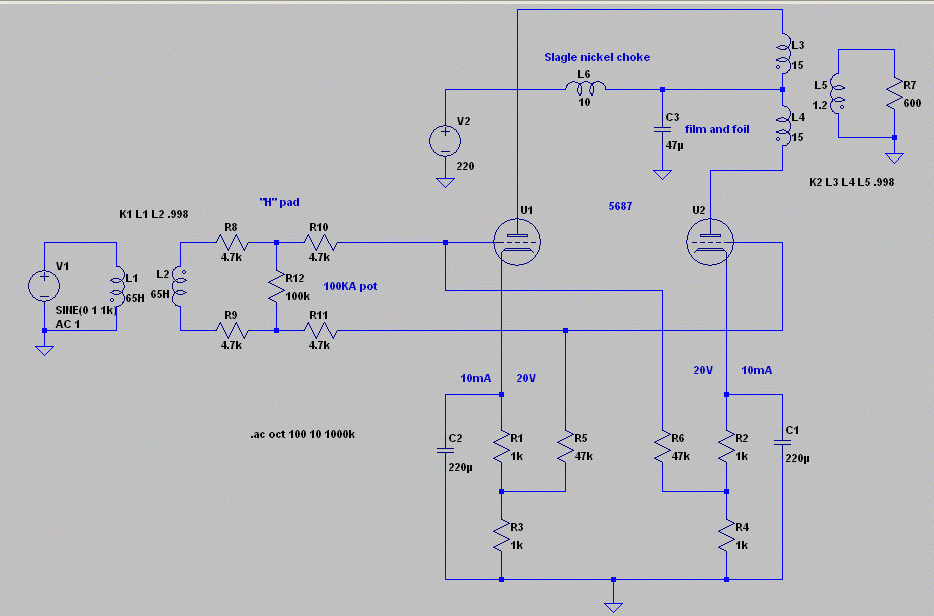this is not part 2 of the mic pre lab.
as a response to a question on the joenet, i am posting a slightly simplified practical version of the silbatone linestage. if you know anything about tube lore, you will recognize alan blumlein’s classic current averaging gadget in the cathode circuit of the 5687/6900. sometimes known as the “garter” circuit (where did this come from?) due to it’s visual similarity to a pair of men’s suspenders. i imagine blumlein pacing in front of an oak desk in his. it still works well today, all these years later. in this arrangement, you see the 1930’s revisited in a thoroughly modern line driver. open loop, the distortion is 70dB down at the 2nd and drops from there across the spectrum. if your trannys are good, expect magnificent results. silbatone uses stuff you can’t get or probably can’t make. but you can use whatever you can get. i would say a pair of lundahl LL7901s and a pair of LL1660PP will fix you up in stereo at a very fair price. if you want to go DEE lux, give slagle, tribute, or your favorite tranny man (cross dresser?) a call.
the biggest difference between what silbatone makes and this schematic is that we currently use a silvercore cobalt amorphous cored stepped transformer attenuator and not the H pad you will see in the schematic. you could use one too, and not use the H pad i have drawn. kristof’s tranny sounds really really great, but, like any tranny, it has trouble with DC across it (when switching) and it needs to be loaded right. there are no tubes which will be perfectly balanced so this circuit will pose a problem for any variable switching thingy you put between the grids. a few words about this: inductors store energy. that is what they do. it takes time to charge and discharge. that is what we take advantage of in filter circuits… so thank goodness something does that job.
it isn’t always a good thing. i am all for inductive attenuators. but i am not at all for cascading inductances one after the other. the problem is lumped poles (multiple storage facilities). it is well understood that one transformer is minimally a 4th order bandpass filter. if you are using 2… you now have a 8th order filter, etc. if you have any appreciation for what that means for the time domain, you will understand why this idea catches in my craw. add another… whew. what we really wanted was to use a slagleformer at the input. yes. that’s what it is called. it’s a very special tapped autoformer attenuator. but, as you can see, we can’t here because the inputs float 20 volts above ground. isolation from the input is a must in this circuit. i will not use a 1:1 tranny followed by an autoformer in a circuit that also uses an output transformer to drive an amplifier that also has an output transformer. no, i am not sakuma. never will be either, and that’s ok. but MJ loves inductive attenuators. so we are changing the circuit in the next iteration so that we CAN use a slagleformer. it will be the only inductor at the input. but it won’t be this circuit anymore.
the finest attenuator i have ever seen was made by siemens. it was a broadcast plugin from the 1960’s. they are occasionally available in europe, but i have never seen one in the states. i don’t at the moment know what it is called. it is a transformer attenuator for mixing with many taps on the secondary. the trans was made by haufe. these taps are shorted with a carbon element which has a rotary slider that makes contact with both the resistor and the tap points. on the front face are markings for the various attenuation levels that correspond to the taps. the resistive shunt allows for going in between the points as well as preventing ANY possibility of ringing by shorting ALL the taps. you can return to fixed attenuation settings for remixes and archive work. the last element of it, which impresses the hell out of me, but is SO anti hifi: the output of the attenuator is buffered. with a transistor buffer. this is how to do it right, in my book, from beginning to end. i would use a tube buffer, myself!
update: peter sikking has identified the gadget in question as a telefunken W690D. he is also the one who told me about it first. it is superlative.
updated update: peter sikking is the one who described this to me, but alexander kliegl showed me a siemens W291. these seem similar? my excitement was completely due to peter’s influence because i had no idea german broadcast made anything like this.
in any case, the H pad is an excellent solution. this way, you can use a 1:1 transformer and have it constantly loaded at any attenuation level.
i hope this will prove interesting. the nickel choke in the B+ line is so important to the sound. the things is great without it, but it is fabulous with it.
